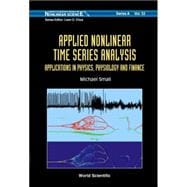
What is included with this book?
| Preface | vii | ||||
| 1. Time series embedding and reconstruction | 1 | (46) | |||
|
2 | (3) | |||
|
5 | (5) | |||
|
6 | (1) | |||
|
7 | (1) | |||
|
8 | (1) | |||
|
9 | (1) | |||
|
10 | (4) | |||
|
10 | (1) | |||
|
11 | (1) | |||
|
11 | (1) | |||
|
12 | (2) | |||
|
14 | (1) | |||
|
15 | (4) | |||
|
19 | (9) | |||
|
21 | (7) | |||
|
28 | (13) | |||
|
30 | (4) | |||
|
34 | (7) | |||
|
41 | (3) | |||
|
44 | (3) | |||
| 2. Dynamic measures and topological invariants | 47 | (38) | |||
|
48 | (6) | |||
|
54 | (15) | |||
|
54 | (4) | |||
|
58 | (2) | |||
|
60 | (9) | |||
|
69 | (5) | |||
|
74 | (6) | |||
|
80 | (2) | |||
|
82 | (3) | |||
| 3. Estimation of correlation dimension | 85 | (30) | |||
|
86 | (1) | |||
|
87 | (3) | |||
|
90 | (5) | |||
|
95 | (7) | |||
|
102 | (3) | |||
|
105 | (6) | |||
|
111 | (4) | |||
| 4. The method of surrogate data | 115 | (34) | |||
|
116 | (4) | |||
|
120 | (5) | |||
|
121 | (1) | |||
|
122 | (1) | |||
|
123 | (2) | |||
|
125 | (4) | |||
|
129 | (4) | |||
|
131 | (1) | |||
|
131 | (1) | |||
|
132 | (1) | |||
|
132 | (1) | |||
|
133 | (10) | |||
|
135 | (1) | |||
|
136 | (6) | |||
|
142 | (1) | |||
|
143 | (4) | |||
|
147 | (2) | |||
| 5. Non-standard and non-linear surrogates | 149 | (30) | |||
|
150 | (5) | |||
|
152 | (1) | |||
|
153 | (2) | |||
|
155 | (2) | |||
|
157 | (9) | |||
|
158 | (3) | |||
|
161 | (2) | |||
|
163 | (3) | |||
|
166 | (2) | |||
|
168 | (6) | |||
|
174 | (2) | |||
|
176 | (3) | |||
| 6. Identifying the dynamics | 179 | (44) | |||
|
180 | (1) | |||
|
181 | (14) | |||
|
195 | (3) | |||
|
198 | (2) | |||
|
200 | (8) | |||
|
200 | (1) | |||
|
201 | (4) | |||
|
205 | (2) | |||
|
207 | (1) | |||
|
208 | (15) | |||
| 7. Applications | 223 | (6) | |||
| Bibliography | 229 | (12) | |||
| Index | 241 |
The New copy of this book will include any supplemental materials advertised. Please check the title of the book to determine if it should include any access cards, study guides, lab manuals, CDs, etc.
The Used, Rental and eBook copies of this book are not guaranteed to include any supplemental materials. Typically, only the book itself is included. This is true even if the title states it includes any access cards, study guides, lab manuals, CDs, etc.